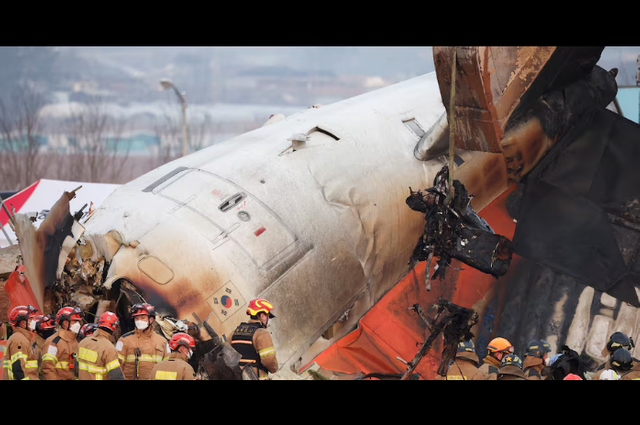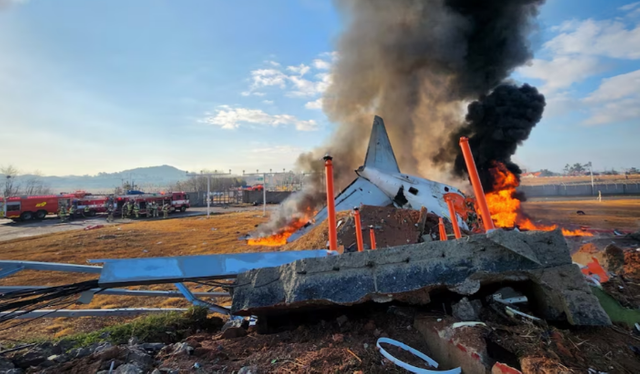Experts suspect bird strike may have caused South Korean plane crash

Dec 29 (Reuters) - Uncertainty surrounding the deadliest crash in mainland South Korea has grown, experts said on Sunday, casting doubt on earlier suspicions that a bird strike may have brought down the Jeju Air (089590.KS) flight. The apparent lack of landing gear and the timing of the twin-engine Boeing Co (BA.N) belly landing have raised questions yet to be answered as reports of a possible bird strike raise questions about why the plane was struck, said a senior official at Muan International Airport, where a new Tab 737-800 is due to open. Video aired by local media showed the narrow-body plane slithering down the runway with no landing gear in sight, before crashing into a wall in an explosion of flames and debris. "Why didn't the fire engines spray foam on the runway? Why weren't they there when the plane landed?" And why did the plane land so far down the runway? And why was there a brick wall at the end of the runway?' asked Airlines News editor Jeffrey Thomas. South Korean authorities have said they are investigating the cause of the crash of Jeju Air Flight 7C2216, including the possibility of a bird strike. The accident killed 179 of the 181 passengers and crew on board. A Jeju Air spokesman was not immediately available for comment. Jeju Air declined to comment on the cause of the accident at a press conference, saying an investigation was ongoing. Under international aviation regulations, South Korea will launch a civil investigation into the crash, which will automatically involve the National Transportation Safety Board of the United States, where the plane was designed and manufactured. The flight data recorder was found at 11:30 a.m. (2:30 p.m. Japan time), about two and a half hours after the crash, and the cockpit voice recorder was found at 2:24 p.m., according to South Korea's Ministry of Transport. "This gives us all the parameters of all the systems of the aircraft. The heartbeat of the plane is recorded in the flight data recorder," Thomas said. "The voice recorder will provide us with the most fascinating analysis of what happened in this tragic accident." Experts note that aviation accidents are usually caused by a confluence of multiple factors, and it can take months to reconstruct the sequence of events on and off the aircraft.The sequence of events Within minutes, the control tower issued a bird strike warning, the pilot called a mayday and then attempted to land, but it was not clear whether the plane struck a bird, officials said. Experts said it was unlikely that a bird strike caused the landing gear failure.

"Bird strikes are not uncommon, and landing gear problems are not uncommon. Bird strikes are much more common, but they don't usually cause the loss of an aircraft by themselves," Thomas said. "I've never seen a bird strike prevent the landing gear from deploying," said Australian aviation safety expert Jeffrey Dell. Trevor Jensen, an Australian aviation consultant, said fire and rescue services would normally be prepared for a belly landing, "so this appears to have been unplanned." If a flock of birds had been sucked in, the bird strike could have affected the CFM International engines, but it would not have shut them down immediately and would have given the pilots time to deal with the situation, Dell said. Dell and Jensen said it was unclear why the plane did not slow down after hitting the runway. In a belly landing, this is what usually happens: "You land on top of the engines and it's a bumpy ride," Thomas said. "If you arrive with minimal fuel, have a fire engine, cover the runway with foam and land at the very end of the runway, you're usually fine." A Transportation Department official said the pilot attempted to land on the runway from the opposite direction after the control tower issued a bird strike warning and the pilot issued a mayday call. "When approaching land, the plane came into contact with a navigation safety device called a localizer and crashed into the wall," the official said. Deputy Transport Minister Joo Jeong-wan said the 2,800-metre-long runway was not the deciding factor and that the end walls were built according to standards. "There are safety zones with green buffer areas at both ends of the runway before reaching the outer walls," he said at a separate press conference. "The airport is designed according to standard aviation safety guidelines, but the walls may appear closer than they actually are." The ministry said the captain had served in this rank since 2019 and had completed 6,823 flight hours. The co-pilot would serve in this rank from 2023 and had completed around 1,650 flight hours. The Boeing 737-800 plane involved in the accident is one of the world's most widely used commercial airliners, has a good overall safety record and was developed long before the MAX planes implicated in Boeing's recent safety crisis.